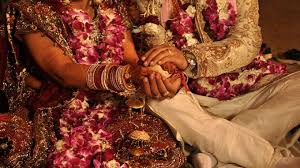Indian Legal System > Civil Laws > Family Laws > The Hindu Marriage Act, 1955 > Conditions for Marriage in Old Hindu Law
In this Article, we shall understand the conditions for marriage given in ancient Hindu texts regarding marriage. Under old Hindu law, three conditions were required for a valid marriage. These were:
Identity of Caste:
The parties in marriage should belong to the same caste unless sanctioned by custom. If this condition is not satisfied, then the marriage was considered to be invalid.
The old texts prescribe two types of marriages with respect to the case: (i) Pratiloma marriage and (ii) Anuloma marriage.
Pratiloma marriage is a type of marital practice in which a man of lower class/caste/varna marries a girl of higher class/caste/varna. It is considered Hypogamy form of Marriage. This type of marriage is prohibited in Hinduism. Anuloma marriage is a type of marital practice according to which a boy from upper varna/caste/class can marry a girl from lower varna/caste/class. It is considered a hypergamy form of marriage. During the Vedic Age inter-class marriages used to take place in the form of Anuloma marriage. But they were only allowed among Brahmins, Kshatriyas, and Vaishyas. Anuloma marriage was normally associated with Hindu polygamy. The association of Anuloma marriage with polygamy led to the ugly practice of dowry.
Anuloma and Pratiloma marriage, as a rule of marriage, is an inseparable part of the Hindu caste system. The rule of Anuloma and Pratiloma marriages has greater significance for the caste structure of Hindu society than for the marriage pattern of the Hindus.
During the British regime, many Acts like Arya Samaj Validation Act 1937, Special Marriage Act 1872, Hindu Marriage Disabilities Removal Act 1946, Hindu Marriage validity Act 1949 were passed to validate inter-caste marriages.
Parties Should be Beyond the Prohibited Degrees of Relationship:
Parties Should be beyond the prohibited degrees of relationship. i.e., were not of the same gotra or pravara and were not the sapinda of each other. This rule is not applicable to shudras, as they had no gotra of their own.
A sapinda relationship, with reference to any person, extends as far as the third generation (inclusive of the third generation) in the line of ascent through the mother, and the fifth generation (inclusive of the fifth generation) in the line of ascent through the father. In determining the sapinda relationship, the line is always to be traced upwards from the person concerned, and such a person has to be counted as the first generation. Two persons are said to be sapindas of each other, if one is a lineal ascendant of the other within the limits of sapinda relationship, or if they have a common lineal ascendant who is within the limits of sapinda relationship with reference to each of them. In Coming Articles, we shall study the sapinda relations in detail.
Proper Performance of Ceremonies of Marriage:
According to Hindu texts, there should be a proper marriage ceremony consisting of Vivah Homa i.e. invocation before sacred fire and saptapadi i.e. seven steps taken by the bride and the bridegroom around the sacred fire. The marriage is complete only when the seventh step is taken. Besides the parties can perform ceremonies as per their customs.
What Changed? Due to the Hindu Marriage Act, 1955
Yagnavalkya in the chapter dealing with marriage stated the conditions necessary for a valid Hindu marriage. The commentators have treated some of the conditions mentioned in this text as mandatory and some as recommendatory.
The mandatory conditions are:
- The bride should not be a sapinda of the bridegroom.
- She should be separated by seven degrees on the father’s side and five degrees on the mother’s side.
- She should not have the same ‘gotra’ or ‘pravara’ as the bridegroom.
- She should not have been married to another earlier.
The recommendatory conditions are:
- She should be good looking.
- She should be younger in years.
- She should be healthy.
- She should have brothers.
The conditions mentioned in Yajnavalkya Smriti have been considerably modified by the Hindu Marriage Act, 1955. The major modifications are:
- According to Yajnavalkya, the bride should be ‘Ananya Purvika’ i.e. she should not have been married to another earlier. So, a widow marriage was not sanctioned.
- According to Yajnavalkya, the bride and bridegroom should not be of the same gotra or pravara. This condition is not prescribed in the Hindu Marriage Act, 1955.
- Yajnavalkya is silent about polygamy. The Hindu Marriage Act, 1955 lays down that neither party should have a spouse living at the time of the marriage. This
entails a prohibition of polygamy and also forbids polyandry. - Yajnavalkya prohibits marriages between sapindas. But according to Yajnavalkya, sapinda relationship extends up to 7 degrees on the father’s side and 5 degrees on the mother’s side. The Hindu Marriage Act, 1955 modifies it and lowers these limits to 5 degrees on the father’s side and 3 degrees on the mother’s side
- Yajnavalkya is silent about the age and mental conditions of the bride and bridegroom at the time of marriage. The Hindu Marriage Act, 1955 lays down that the bridegroom should have completed 21years of age and the bride, 18 years at the time of the marriage. Similarly the Act lays down that at the time of the marriage, neither party a) is incapable of giving a valid consent to it in consequence of unsoundness of mind; or b) though capable of giving a valid consent, has been suffering from mental disorder of such a kind or to such an extent as to be unfit for marriage and procreation of children; or c) has been subject to recurrent attacks of insanity or epilepsy.
Previous Topic: Forms of Hindu Marriage
Next Topic: Changes Brought About by the Hindu Marriage Act
